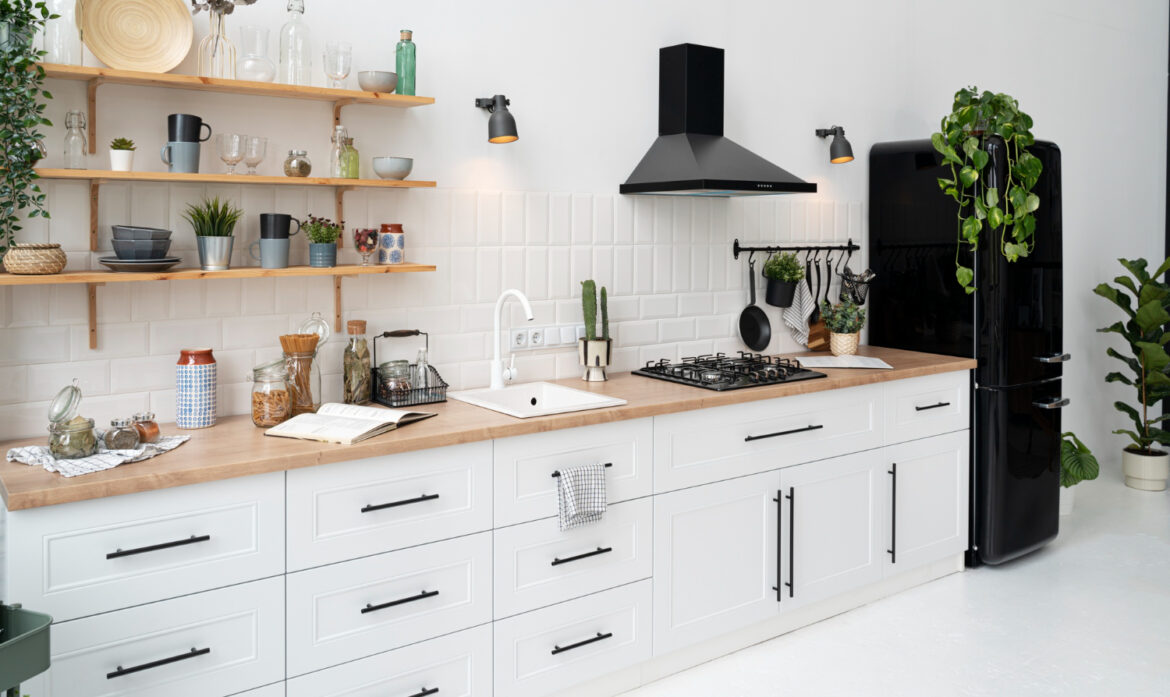Key Takeaways:
- Understanding the importance of layout in kitchen design.
- The role of color, materials, and lighting in enhancing kitchen aesthetics.
- Ways to incorporate modern technology for a smart kitchen.
- Design tips for optimizing small kitchen spaces.
Introduction to Kitchen Layouts
Designing a kitchen that is both functional and stylish begins with understanding the importance of the layout. A well-planned layout ensures a seamless workflow, making cooking and cleaning tasks more efficient and enjoyable. Common kitchen layouts include the galley, L-shaped, U-shaped, and open-plan layouts, each offering unique benefits depending on the space available. For example, a galley layout is great for small spaces. In contrast, an open-plan layout breaks down barriers and encourages social interaction. Moreover, integrating high-quality custom cabinets can greatly enhance any kitchen design’s functionality and aesthetic, providing ample storage options tailored to your needs.
The Role of Colors and Materials
The kitchen ambiance is influenced by colors and materials, with neutral tones enhancing size and timeless hues like whites and grays, while bold colors add personality and warmth. Additionally, choosing the right materials for countertops, cabinets, and flooring is essential for creating a cohesive and durable kitchen design. For example, quartz countertops are stylish, highly durable, and resistant to stains, making them a popular choice for many homeowners. Similarly, hardwood floors offer warmth and charm while sturdy enough to handle the frequent foot traffic of a busy kitchen.
The Importance of Proper Lighting
Lighting is a critical component in kitchen design, impacting functionality and aesthetics. Proper lighting enhances visibility, making it easier to perform cooking, cleaning, and food preparation tasks. Additionally, it creates an inviting atmosphere that can make the kitchen a more pleasant space to spend time in. Combining various lighting styles, such as task, ambient, and accent lighting, can greatly enhance the appearance and use of the kitchen. Effective kitchen lighting solutions include recessed lights for general lighting, under-cabinet lights for task lighting, and pendant lights above islands for accent lighting. These varied light sources can be strategically placed to highlight key areas and create a balanced, well-lit environment.
Incorporating Modern Technology
The integration of modern technology can elevate the design and functionality of your kitchen, making daily tasks more convenient and efficient. Smart appliances, such as touchless faucets and Wi-Fi-enabled refrigerators, offer convenience and enhance the cooking experience. For example, a smart oven can be preheated from your smartphone, saving time and energy. Additionally, incorporating a smart home system can allow for seamless control of lighting, temperature, and security, making your kitchen more efficient and user-friendly. Features like voice-controlled assistants can help you with recipe instructions, shopping lists, and even controlling other smart devices in your kitchen, creating a truly integrated cooking environment.
Design Tips for Small Kitchens
Designing a small kitchen can be challenging, but with the right strategies, it’s possible to create a compact space that is both functional and stylish. Utilize vertical storage solutions like tall cabinets and wall-mounted shelves to maximize space. These solutions can help keep your countertops clutter-free and maximize every inch of available space. Opt for a light color palette to make the kitchen appear larger and more open, and choose multi-functional appliances to save on countertop space. For instance, a microwave-convection oven combo can serve multiple purposes, freeing up valuable kitchen real estate.
Sustainable Kitchen Design
Sustainability is becoming increasingly important in modern kitchen design. The environmental effect of the kitchen can be decreased by including energy-efficient appliances and eco-friendly materials like bamboo or salvaged wood. For instance, bamboo is a strong, fashionable, and rapidly renewable resource that may be used for flooring or cabinetry. Installing energy-efficient equipment can also drastically cut energy use and utility costs. Examples of such appliances are dishwashers and refrigerators with ENERGY STAR ratings. Installing a composting system and opting for water-efficient fixtures are practical steps towards creating a more sustainable kitchen. These elements help conserve resources and contribute to a healthier living environment.
Final Touches to Enhance Kitchen Design
The final touches in kitchen design can tie the entire space together, making it feel complete and personalized. Accessories like stylish bar stools, decorative backsplashes, and unique cabinet handles can reflect personal style and add character to the kitchen. For example, a colorful mosaic backsplash can be an eye-catching focal point. At the same time, custom cabinet handles can add a touch of elegance or whimsy. Additionally, incorporating natural elements like indoor plants can bring a touch of nature, improving air quality and adding a fresh, vibrant feel to the space. Plants like herbs can also be practical, providing fresh ingredients for cooking. For more inspiration, consider browsing some kitchen design ideas from reputable sources, offering a wealth of creative solutions and design trends to explore.
Conclusion
Crafting a kitchen that balances functionality with style requires careful consideration of layout, colors, materials, lighting, and technology. Whether you’re working with a large space or a small kitchen, the right design strategies can transform any kitchen into a welcoming and efficient hub for your home. By focusing on key elements such as layout efficiency, smart storage solutions, and sustainable materials, you can create a kitchen that meets your practical needs and reflects your style and values.

